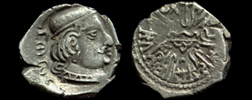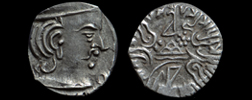|
|
The Scythian Western Kshatraps were not conquered, and even survived the Khushan Empire, of which they were either vassals or allied. Kushan suzerainty is attested by some documents only during Kanishka 1 rule were Saka rulers of the Western and Central Part of India (including Southern Sindh). There were 27 independent Western Satraps rulers during a period of 350 years. They formerly started with Kshaharata dynasty (6 CE Taxila Copper plate inscription mentions this), founded by Nahapana, who only used title of Satrap on his coins not Raja or Rano (King).
Kardamaka dynasty, family of Castana (2nd -4th Cent.), was established by �Satrap� Castana Circa 130 CE, he was Satrap of Ujjain.
Around 130 CE, Rudradaman I, grandson of Castana took the title �Mahakshatrapa� (Great Satrap) and defended his Kingdom from Satavahanas. Rudrasena II (256-278 CE) took the dynasty at its peak, the last ruler of this family was Visvasena.
The Kshatrapas have a very rich and interesting coinage, based on the coinage of Indo-Greeks, with Greek or Pseudo - Greek legend and life like profiles of royal busts on the obverse. The reverse is known original and depicts a thunderbolt and an arrow, and later, a chaetya or three arched hill and river symbol with a crescent and sun, within Brahmi legend. These coins are very informative as they record the name of the king, of his father, and date of issue.
Regnal dates: from Rudrasimha I, the date of minting of each coin, is written on the obverse behind kings� head in Brahim numerals, which is uncommon case in Indian Numismatics.
The coins of Nahapana bears Greek legend �PANNI IA HAPATAC NAHA ANAC� (Rano Kshaharatasa Nahapanasa). In the reign of Kshaharata Nahapana. Casatana also have legend �PANNI IATPA AC CIASTANCA� (Rano Kshatrapasa Castana), in the reign of the Satrap Castana.
The coins of Kshatrapas were also initiated by Satavahanas, and Guptas, such as silver coins of Chandragupta II and his son Kumaragupta I.
|
|
|
| Sassanid Empire (The return of Persian rule � until 410 CE)
The Parthian and Kushan domains were superseded by the Sassanids.
In the Indus Valley, the Sassanids conquest did not completely obliterate the Kushan Kingdom, which survived at the east of Indus till 320 CE and the Scythian Western Ksharapas, ruled until 405 CE. The collapse of Kushan enabled the expansion of Gupta Empire upto Sutlej Indus Line.
The Gupta Empire
The Guptas arose as the rebuilders of Maurayan Empire. They achieved in ruling over the territories which were once ruled by Maurayas, after the five centuries of foreign dominion.
The Hephthalites
Hunas or �White Huns�, determined the end of the Gupta Empire, settled capital at Sakala (Sialkot). Descending from Central Asia
invaded Sassanian Empire in 425 AD.
Contemporary with later Hephthalite period and ending stage of Sassanid rule, the Rai dynasty, a Mauryan Line of Kings reigned over Sindh. The Sassanid Empire fell under the Arabs.
The Huns were instrumental in circulating the currency of Sassa main types in India. These Sassanian coins became prototype throughout the Rajputana Region.
|


